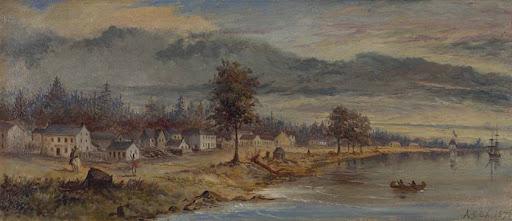________________________________________________________________
History has been making the news since various heritage groups began reminding Canadians of the 200th anniversary of the War of 1812. April 27th, 2013, is of particular interest to Torontonians, as it marks two centuries since Americans brought the war to the townspeople of York. Throughout 2013 (and maybe, into 2014) my "Toronto Then and Now" blog will look at the various buildings of the Town of York scattered througout Toronto. Most of them have disappeared, though a few still remain. Some had obvious connections to the War of 1812, but some did not.
For those of you who are interested in more contemporary history, don't worry, I'll post that, too. But from time to time there will be posts to commemorate the 200th anniversary of the War of 1812. After all, I don't post on a regular basis, and it's a long wait for the 300th anniversary!
________________________________________________________________
Russell Hill, the home of Augustus
Warren Baldwin, was built in 1818, near the north end of Glen Edyth
Drive.
Augustus Warren Baldwin was born on
August 1, 1776, in Ireland. He was the sixth of sixteen children
born to Robert Baldwin, Sr., and his wife Barbara. History has often
left him eclipsed by his brother, William Warren Baldwin, and his
nephew, the great Canadian reformer, Robert Baldwin.
Augustus Baldwin entered the Royal Navy
in January of 1792, while he was still a teenager. He served at sea
for about a quarter of a century. In 1807, the British feared that
Napoleon might coerce the Danish fleet into closing the Baltic Sea,
thus forcing out British ships.. The result was the Battle of
Copenhagen, in 1807. Baldwin was there, participating in the
bombardment unleashed upon Copenhagen. The Danish fleet fell into
British hands. In 1808, Baldwin aided in the capture of a Russian
ship, and was decorated and given his own command as a result. He
commanded a brig in the English channel for some time, but eventually
retired from the Navy, and joined his family in York in 1817.
 |
| THEN : The bombardment of Copenhagen in September of 1807. |
He purchased two hundred acres of land
from Elizabeth Russell, buying property that lay just east of his
brother William Warren Baldwin's estate, Spadina. Augustus Baldwin
named his estate Russell Hill, both after the farm of the same name
that he'd been born at, in Ireland, and as a tribute to Elizabeth
Russell. From here, he could look down over the escarpment towards
the Town of York, which lay nearly five kilometres off in the
distance. The two-storey house at Russell Hill was built in the
Regency style, and had a verandah lining the exterior. Baldwin
married Augusta Mary Jackson in October of 1827, and together, the
couple began a family at Russell Hill. They had a son and two
daughters but sadly all three children would die in their teenage
years.
By 1822, August Baldwin was serving as
a magistrate, and in 1823, he was working as a commissioner,
investigating the claims of those who had suffered financial loss
during the War of 1812. These claims were still being turned in
nearly a decade after that war had ended. Baldwin had investments in
York, loaning £1,000 to the merchant Laurent Quetton St. George,
partnering with other Baldwin family members in ship construction,
and putting a great deal of money in the Bank of Upper Canada. The
bank would be a disappointing investment when it collapsed,
financially, and ceased to exist. However, since the bank failed
after Baldwin's death, it was more of a concern for his heirs than
for him. Baldwin's most significant financial legacy was real
estate.
Baldwin gained a seat on the
Legislative Council in 1831. In the spring of 1836, when Baldwin's
nephew Robert led a mass resignation of reformers from the Executive
Council, Lieutenant-Governor Sir Francis Bond Head asked Augustus
Baldwin to serve on that council, and he accepted. Augustus Baldwin
was much more of a Tory than his brother or his nephew. However,
Robert Baldwin's political contributions to Canada are still
remembered today, while his uncle Augustus Baldwin is largely
forgotten. Augustus remained on both the Executive Council and the
Legislative Council of Upper Canada until 1841.
Augustus Baldwin's final years were
mostly spent in leisure, and he died at Russell Hill on January 5,
1866. His wife, Augusta, moved out of Russell Hill in 1870, and the
house was demolished in 1872. A later estate, Glen Edyth, was built
on the same site by the Nordheimer family, but it was demolished in
1929. Today, Admiral Road – after Baldwin's highest rank in the
navy – and Russell Hill Road are commemorations of Admiral Augustus
Warren Baldwin and his home at Russell Hill.
 |
| THEN : Russell Hill, the home of Augustus Warren Baldwin, stood from 1818 until 1872. |


